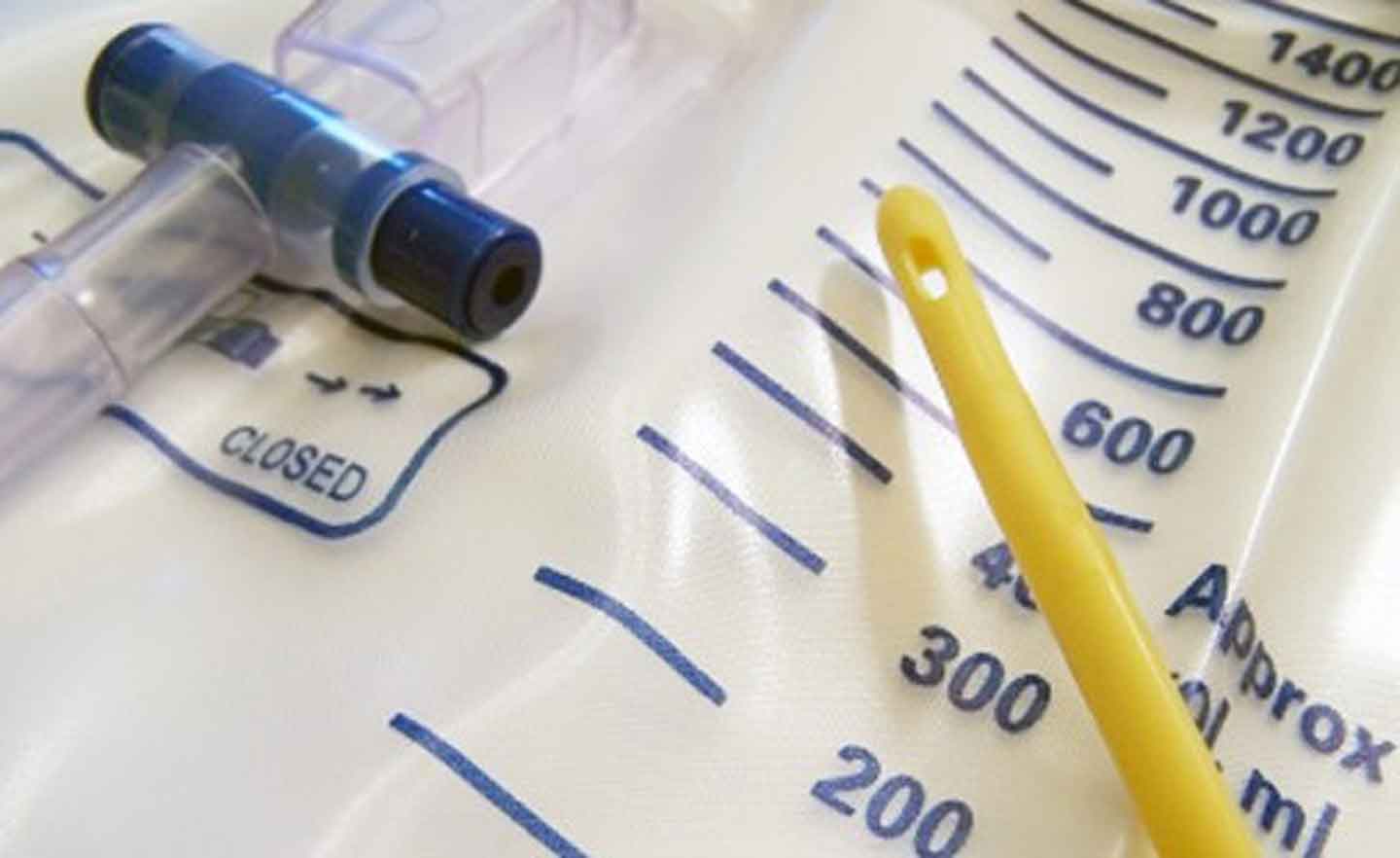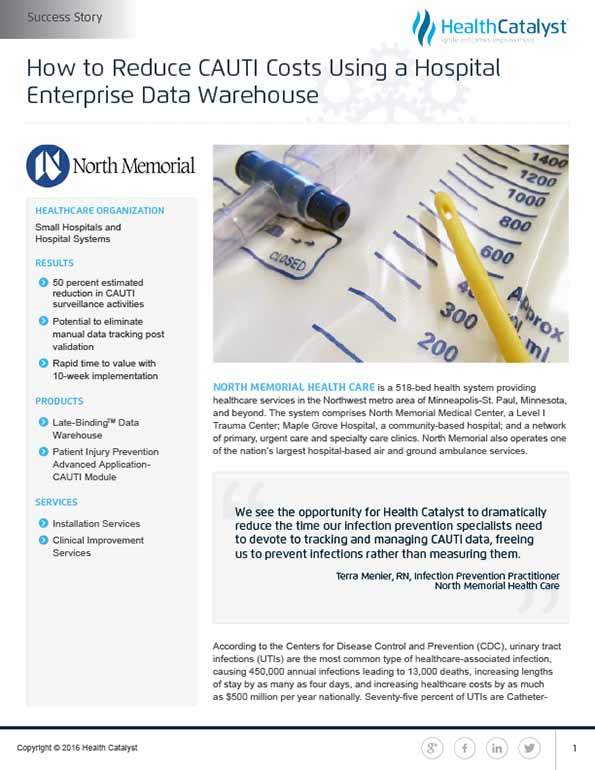Urinary tract infections (UTIs) are the most common healthcare-associated infections, with 450,000 annual cases, causing 13,000 deaths and significant increases in hospital stays and costs. Seventy-five percent of these are catheter-associated UTIs (CAUTIs). To meet new CMS reporting requirements, North Memorial Health Care expanded its CAUTI monitoring across multiple facilities by utilizing Health Catalyst's Late-Binding™ Enterprise Data Warehouse and Patient Injury Advanced Application CAUTI Module.
North Memorial Health Care is a 518-bed health system providing healthcare services in the Northwest metro area of Minneapolis-St. Paul, Minnesota, and beyond. The system comprises North Memorial Medical Center, a Level I Trauma Center; Maple Grove Hospital, a community-based hospital; and a network of primary, urgent care and specialty care clinics. North Memorial also operates one of the nation’s largest hospital-based air and ground ambulance services.
According to the Centers for Disease Control and Prevention (CDC), urinary tract infections (UTIs) are the most common type of healthcare-associated infection, causing 450,000 annual infections leading to 13,000 deaths, increasing lengths of stay by as many as four days, and increasing healthcare costs by as much as $500 million per year nationally. Seventy-five percent of UTIs are Catheter-Associated Urinary Tract Infections (CAUTIs), and 15-25 percent of hospitalized patients receive urinary catheters during their hospital stay.
To satisfy new proposed Centers for Medicare and Medicaid Services (CMS) reporting requirements, North Memorial Health Care needed to expand its CAUTI monitoring – a time- and labor-intensive process for even one unit – to track patients in all their units across multiple facilities. Their solution: leverage existing Late-Binding™ Enterprise Data Warehouse (EDW) and Patient Injury Advanced Application- CAUTI Module solutions from Health Catalyst.
“We see the opportunity for Health Catalyst to dramatically reduce the time our infection prevention specialists need to devote to tracking and managing CAUTI data, freeing us to prevent infections rather than measuring them.”
-Terra Menier, RN, Infection Prevention Practitioner, North Memorial Health Care
North Memorial understood the challenge of increased data scope. In 2010, when the Robbinsdale, Minnesota-based health system expanded to a second hospital, it invested in a hospital EDW from Health Catalyst.
By aggregating data from North Memorial’s disparate systems with its Epic electronic health record (EHR), the EDW allowed the health center to manage data on an enterprise level – which is precisely how CMS is now proposing CAUTI be tracked.
But the health system had not yet leveraged the EDW to address CAUTI. Terra Menier, R.N., and Infection Prevention Practitioner at North Memorial, explained how CAUTI monitoring worked at the time: “At the end of the month, decision support ran reports of all ICU patients. I’d have to go through the 30-page reports, identify Foley catheter patients with positive urine cultures, and then pull their charts to determine if they met the NHSN definition for CAUTI. It took anywhere from eight to 16 hours each month and that was just for ICU at
our facilities.” If North Memorial were to scale the old process to hospital-wide surveillance across all units, Menier estimates the surveillance could increase by another eight to 16 hours.
The current process at North Memorial requires an ICU charge nurse to mark down how many ICU patients have a urinary catheter, central line or are on a ventilator every night at midnight. These manual forms are then faxed to the infection prevention team and entered into surveillance graphs. North Memorial is currently validating the data with their manual reports over a 3 month period. They expect to eliminate the need for charge nurses to manually track and submit data, freeing up busy charge nurses to focus on patients versus reporting.
In June, 2013, North Memorial began deployment of the Health Catalyst CAUTI module within the hospital EDW.
A mere 10 weeks from the decision to implement, the system was running its first reports. Health Catalyst estimates an 80 to 90 percent reduction in surveillance activities once North Memorial completes validation based on other client’s quantitative analysis. With the Health Catalyst Application, the system estimates tracking and management resources for all units and both facilities will decrease significantly.
The effect will be freeing up of data specialists’ and infection preventionists’ time. Data specialists no longer have to cobble together reports manually. Health Catalyst’s data automation allows them to move from data gathering and report generation to providing analysis.
Menier cites more time to operate at the top of her license, moving from manual chart abstraction to delivering improved patient care. “We’re extremely strapped for time in the infection prevention world,” she said, “and CMS is coming out with new regulations every year.”
“The more we’re out there preventing – rather than measuring – infections, the bigger a difference we can make, educating clinicians and, as a result, increasing patient safety and quality.”
While the immediate need is data tracking, North Medical plans to use the Health Catalyst solution to achieve several longer-term patient care improvement goals.
Next steps include validating the algorithm by comparing six months of Health Catalyst-generated data against the results of chart review by infection preventionists. Once validated, North Memorial plans to roll the solution out to all units across their enterprise, continuing to monitor compliance, and tracking the impact of the solution on CAUTI rate reductions.
Eventually, North Memorial plans to leverage the hospital EDW and additional Health Catalyst Patient Injury Prevention Advanced Applications to implement` additional infection prevention measures.




